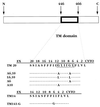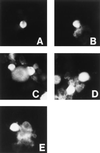The transmembrane domain in viral fusion: essential role for a conserved glycine residue in vesicular stomatitis virus G protein
- PMID: 9520382
- PMCID: PMC19852
- DOI: 10.1073/pnas.95.7.3425
The transmembrane domain in viral fusion: essential role for a conserved glycine residue in vesicular stomatitis virus G protein
Abstract
The transmembrane (TM) domains of viral fusion proteins are required for fusion, but their precise role is unknown. G protein, the fusion protein of vesicular stomatitis virus, was previously shown to lose syncytia-forming ability if six residues (GLIIGL) were deleted from its TM domain. The 20-residue TM domain of wild-type (TM20) G protein was thus changed into a TM domain of 14 residues (TM14). To assess possible sequence specificity for this loss of function, the two Gly residues in TM20 were replaced with either Ala or Leu. Both mutations resulted in complete loss of fusion activity, as measured by fusion-dependent reporter gene transfer. Single substitutions decreased activity by about half. TM14 was weakly active (15%) but reintroduction of a Gly residue into TM14 by a single Ile --> Gly substitution increased activity to 80%. All mutants retained normal hemifusion activity, i.e., lipid mixing between the outer leaflets of the reacting membranes. Thus, at least one TM Gly residue is required for a late step in fusion mediated by G protein. Gly residues were significantly (2.6-fold; P = 0.004) more abundant in the TM domains of viral fusion proteins than in those of nonfusion proteins and were distributed differently within the TM domain. Thus, Gly residues in the TM domain of other viral fusion proteins may also prove to be important for fusion activity.
Figures






References
-
- Kemble G W, Danieli T, White J M. Cell. 1994;76:383–391. - PubMed
MeSH terms
Substances
LinkOut - more resources
Full Text Sources
Other Literature Sources

